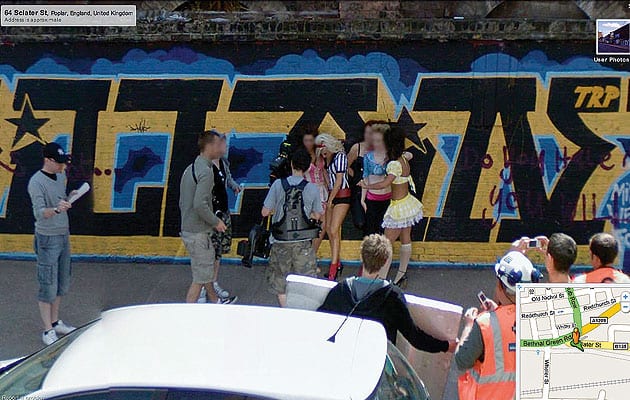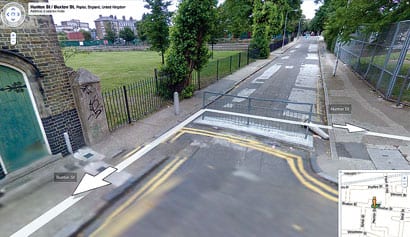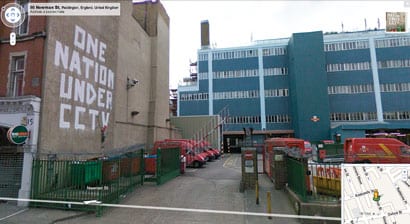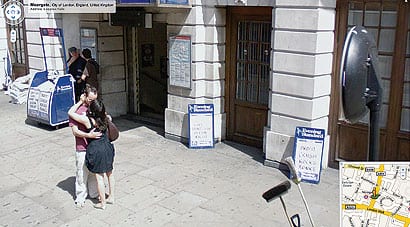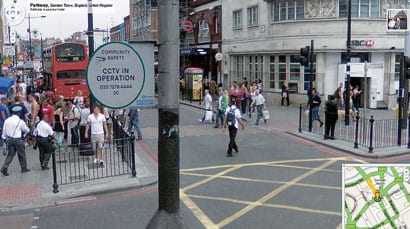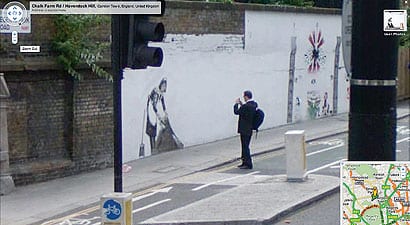|
Photoshoot on Brick Lane |
||
|
Google marches towards its destiny of total information awareness, bringing the all-seeing eye of Street View to 25 UK cities. It’s a great leap forward that is instantly out of date, says Alex Haw. Given we’re the world leader in pervasive surveillance, it’s amazing that it took this long to get Google Street View (GSV) in the UK. Perhaps we can blame the weather: the Guardian claimed that the Google Car cameras were useless in rain. We seemed doomed to a monotonous flatland existence, endlessly zooming in and out of 2D Google Maps like bored CAD monkeys. Then, on 18 March, the UK was suddenly online in 3D, with the streets of 25 cities navigable through Google’s immersive 360-degree photography. All those plans suddenly sprung elevations. UK internet traffic rose 41 percent and one in every 250 web users was logged walking the Google Streets. We were all walking not only through the web, but the expanded time capsule of our country, gazing at our frozen world – the passing Google Car, like the gaze of the Medusa or the eruption of Vesuvius capturing us forever in that random Pompeian moment. Underlining this browsing of an England embalmed in time, the Tate has already designed a GSV service where you can place yourself in the exact viewpoint from which Constable and Turner once painted. Contemporary art has also been preserved; Banksy’s “One Nation Under CCTV” mural, stealthily painted under the gaze of cameras almost exactly a year ago, was effaced in March, but not before GSV memorialised it. Google won the Information Commissioner’s approval in July 2008, continuing its European policy of blurring any identifying characteristics like faces or number plates. It had been collecting UK footage for over a year, scanning more than 22,369 miles of road with cars topped by various arrays of camera clusters, GPS, 3G/Wi-Fi aerials, and Laser Range Finders that suggest the use of non-photographic point-cloud data for modelling in Google Earth. There’s been a global frenzy of Google Car-spotting from Bucharest to Bishan, Taiwan to Tunisia, with dedicated Flickr groups and (of course) Google Maps of sightings. China’s City8, launched a year before GSV, is way ahead, offering panoramas at twice the pixel resolution which you can tag with comments, and actually enter – leaving the public streets to enter private rooms, navigating the heart as well as the surface of the city, like a spatial version of the Yellow Pages. The original GSV rolled out in San Francisco in July 2007 and immediately sparked a craze for a second round of scanning. “Google Sightseeing” highlights GSV’s original blow-by-blow account of an unfolding streetfight, elegantly storyboarded from argument to bloodletting. People began poring over the footage for evidence of crime, nudity or laughs. Within 24 hours of the UK launch, bloggers had identified instances of projectile vomiting, stone-throwing, drug-dealing, pissing in public, consumer sex, marital infidelity, and police arrest. A wave of complaints removed the imagery within a day – too late to prevent it being downloaded and preserved for posterity on other websites. A chart of all the censored blackspots will be the next great map – a refuge from observation, a new urban wilderness, an extraordinary collaboration between temporal accident and geographic circumstance, centralised software and popular demand. It’ll be an anti-tapestry of our time, an archive of the shadow of current events – witness the recent (bungled) removal of disgraced banker Sir Fred Goodwin’s house from view. Street View space looks normal, but is deeply strange. The Sanborn maps of New York City used to be updated by someone sticking a new piece of city over the last, thickening over time. Street View stitches together both time and space in an irrecoverable sequence of momentary scans. Moving through them is less like flipping through a palimpsest than it is like gliding randomly between cinema screens where you can’t tell whether you’re watching the film running forwards or backwards, or even whether it was made sequentially by a single author. Soon enough, given Google’s godly ambitions of total information, I presume the footage will cease to be lifeless and become real-time video, an expanse of endless surveillance where moments will no longer be memorialised but rather washed ever onwards in the flood of data. And we, in return, will spawn entirely new spatial strategies to either maximise or minimise our ongoing visibility – a monumental on/off-line battle between privacy and publicity.
If you can’t drive it, you can’t see it
More Banksy
Canoodling in Covent Garden
Watching the watchers in Covent Garden
A Banksy mural in Camden maps.google.co.uk |
Words Alex Haw |
|
|
||

